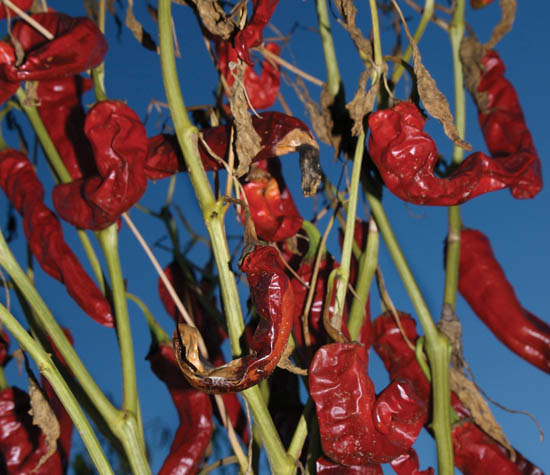“Sin agua, no hay vida.” This traditional saying, which translates as “Without water, there is no life,” reflects a fundamental New Mexican reality.
The most valuable commodity in New Mexico is not gold. Despite early explorers’ fanciful tales of Indian cities whose streets were said to be paved with gold, very little in the way of precious metals has ever been discovered here.
Nor is land the most treasured commodity. The fifth largest state in the United States, New Mexico has vast expanses of land—an arid sea of crackled clay and sand punctuated by island-like evergreen-clad peaks reaching down from the southern tip of the Rocky Mountains near Santa Fe.
The most prized gift of nature in New Mexico, without a doubt, is water. The average precipitation in five representative cities and major towns near the Rio Grande—Taos, Los Alamos, Santa Fe, Albuquerque, and Las Cruces—is 13.25 inches a year. This is not a great deal of moisture. But according to the common meteorological definition of a desert (ten inches or less), New Mexico is not a desert at all. The state receives about the same amount of rainfall as Los Angeles and three times as much as Las Vegas. However, it is not simply a lack of rainfall that makes the landscape so dry.
Several factors besides rainfall combine to give New Mexico’s terrain its desert character. At lower elevations, almost all the annual precipitation comes during the two-month monsoon season, from early July through August. In the winter, most snow falls on the high mountains, accumulating until the spring thaw, when it runs off into flash-flooding arroyos, swollen creeks, and raging rivers that are dry the rest of the year. The water rushes away down sunbaked slopes with little time to soak into the earth. Although much of the water is captured in large reservoirs along the Rio Grande and Chama rivers, this water is not available for use by either rural or urban New Mexicans. It is reserved for downstream big agriculture in Texas.
As a result, water is a surrealistic commodity in New Mexico. The water captured in man-made lakes is only available for fishing and boating. As far as drinking water or irrigation water are concerned, it might as well not exist. On the other hand, legal water rights claims often relate to “dry water”—water that in fact does not exist.
For many reasons, New Mexicans already face the kind of freshwater problems that will become more acute around the globe in the near future: conflicts between urban and rural users, conflicts between indigenous users and post-colonial governments, and conflicts of law about how water rights are defined, to name just a few.
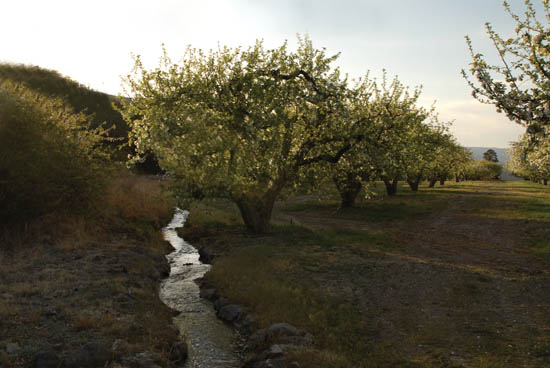
acequia at Dixon’s Apple Orchards
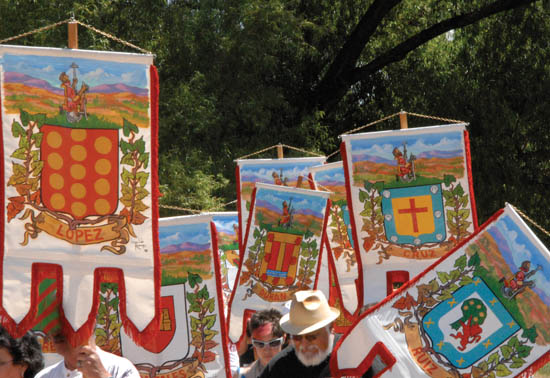
New Mexico’s small farmers live on the forefront of all these issues, and sometimes the unpredictable rainfall can make their lifestyle tenuous. In the years 2002 through mid-2006, the worst drought since weather records began struck New Mexico. Precipitation declined to less than half the seasonal norm, and the normally semiarid landscape became one of the driest deserts in the United States. Streams and acequias dried up, and small farmers were forced to install drip irrigation to survive. Trees died by the hundreds of thousands. Cities like Santa Fe imposed draconian water restrictions that banned all outdoor uses of water, including gardening, landscaping, and even car washing. Yet suburban housing development continued unabated, taking it on faith that the rainfall would return one day.
And it did. In July and August 2006, after a dry spell when no trace of moisture had fallen in eight months, drenching storms came and lasted for two full months, breaking records for rainfall. Acequias, the traditional irrigation ditches that crisscross the farmlands, backed up and flooded crop fields. Hardest hit were the chile fields around Hatch in southern New Mexico. This and other areas of the state were declared federal disaster areas because of flood damage.
Be careful what you wish for . . .
Acequia Culture
From the Middle East to the New World
Acequia is the Spanish version of a Yemeni word for “irrigation ditch.” Like many aspects of life in Spanish colonial New Mexico, such as adobe brick homebuilding, acequia technology flowed here from the Middle East by way of Spain. More than water delivery systems, acequias became the basic building blocks of rural society, linking New Mexico’s farmers to those who came before across vast expanses of distance and time. Today in the United States—except for a handful of historic curiosities at some restored Spanish mission churches in Texas and California—acequias exist only in New Mexico.
When the first Spanish farmers arrived in New Mexico four centuries ago, they found that the Pueblo Indians were diverting water into their fields from earthen reservoirs by means of irrigation ditches that looked very similar to the ones their families back in Spain had used. The essential difference was that the acequia system of old Spain and Arabia used gates to let water onto one farmer’s property and then the next, while the Indians worked all their cropland communally. Both systems allowed water to be shared equitably in a climate where water availability was often unpredictable or scarce. As the settlers knew, the acequia system had been working in the Middle East since biblical times.
The first Spanish farmers came to New Mexico for the same reason as the English-speaking Pilgrims, who founded their smaller colony thousands of miles away on the continent’s east coast a generation later: to escape religious persecution. Since AD 711, Spain had been occupied by the Moors—Islamic North Africans whose armies had invaded across the Strait of Gibraltar. The Moors, as well as the Sephardic Jews who migrated into Spain in search of vacant land during the centuries that followed, were educated in ancient Middle Eastern agricultural methods dating back to around 8000 BC. Efforts by Christian armies to reconquer Spain began almost immediately and continued in different provinces, with varying degrees of success, for nearly eight centuries.
Spain was finally united under the Catholic monarchs Fernando and Isabel in 1492. The end of the war against the Moors freed up funds to finance exploration and colonization efforts. Just seven months later, the king and queen commissioned navigator Cristóbal Colón (known in his native Italy as Cristoforo Colombo and later, in the English-speaking world, as Christopher Columbus) to lead an ocean expedition across the Atlantic.
Neither religious tolerance nor the separation of church and state was recognized in European nations at that time. Jews and Muslims living in Spain after the reconquest were required by law to become Roman Catholic converts or to leave Spain. Those who stayed, including an estimated one hundred thousand converted Sephardic Jews—a large percentage of the country’s total population at that time—were called conversos (converts), or, more pejoratively, marranos (swine), a double entendre mocking their dietary prohibition against eating pork. Despite persecution in some provinces of Spain, conversos often held on to past positions of wealth and power, which fostered further resentment. In the sixteenth and seventeenth centuries, the Spanish Inquisition—a court originally designed to prevent the “heresies” of Protestantism—turned its attention to the problem of the conversos. In a series of trials, Jewish converts were charged with privately practicing Judaism, prosecuted for heresy, and publicly burned at the stake in the Inquisition’s notorious autos-da-fé. By the time of the colonization of Mexico, secret Jews had become the main focus of the Inquisition. Extortion by neighbors, along with the church’s confiscation of land, property, and money as part of the punishment for those convicted of heresy, made Spain a dangerous place for conversos—wealthy aristocrats and subsistence farmers alike.
The solution for many was to leave Spain, booking passage for remote areas of the Spanish-speaking New World. In places like New Mexico, the church was represented by Franciscan missionaries. Preoccupied with bringing the Gospel to local Indians, the Franciscans had no interest in whether Spanish farmers had sincerely relinquished Judaism or not. Fray Angélico Chávez (1910–1996), a renowned New Mexico historian best known for his genealogy of the origins of New Mexico families during the Spanish colonial period, asserted that more than half the settlers who came to New Mexico in the 1600s—including his own ancestors—were of Jewish descent.
New Mexico’s Semitic roots matter because the Spaniards who conquered the New World on behalf of Spain were predominantly military men, nobility, and bureaucrats. They knew little of farming. Under the feudal system in Mexico, army commanders and government functionaries were rewarded for their service with land grants while the actual work of growing crops and livestock was performed by the same native people who had always lived on the land. But in the remote land of New Mexico, the situation was different.
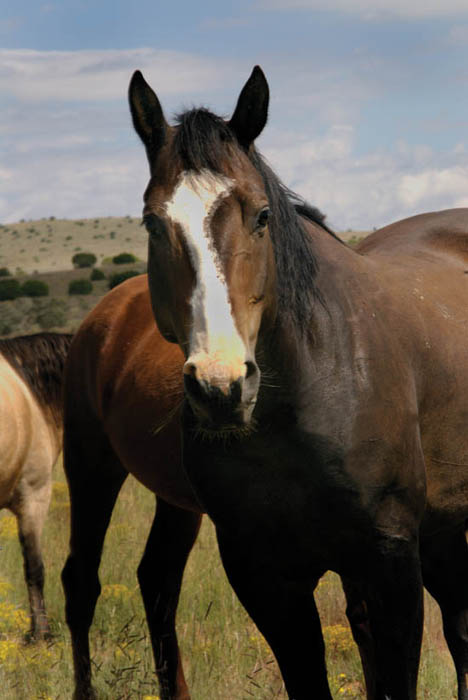
How Colonial Farmers Came to New Mexico
At the end of the sixteenth century, the king of Spain decided to establish a northern outpost that would serve as a buffer between Mexico, then known as Nuevo España, and the vast, largely unknown lands to the north. The colony would protect Mexico from invasion not only by nomadic Indian tribes but also by English-speaking adventurers. Although no British colony had yet been established anywhere in the Americas, the recent defeat of the Spanish Armada meant that it was only a matter of time. Having decreed the colonization of Nuevo Mexico on the northern outskirts of the desolate Chihuahua Desert, the crown offered leadership of the expedition to the highest bidder. The winner was Juan de Oñate, a silver baron in the town of Zacatecas, New Spain. One of the richest men in the country, Oñate was the grandson-in-law of conquistador Hernán Cortés and his mistress, La Malinche, Aztec king Moctezuma’s daughter. Oñate was to organize the expedition at his own expense, buy all needed provisions, and recruit colonists. In exchange, he would receive a large tract of land, including “ownership” of all the Indians that lived on it.
When Oñate’s expedition set out in the year 1598, it consisted of about 130 farmers, mostly conversos, and their families, along with 200 soldiers and ten Franciscan missionaries. They brought 1,100 cattle, 4,000 sheep, 1,000 goats and 300 horses—the first livestock to be raised on New Mexican farms. Before that, the Pueblo Indians had kept dogs and turkeys, but there is no evidence that they used either one for food. Turkeys were raised as a source of feathers for ceremonial decoration and blanket weaving, and dogs were apparently used only as hunting companions and household pets.
Oñate, though a rich businessman, proved to be a poor leader. Hoping to find a route up the Rio Grande to the mythical Straits of Anian—a passage thought to connect the Mississippi River with the Pacific Ocean—Oñate brought a full complement of sailors and shipbuilding equipment, but he did not bring enough supplies for his farmers, soldiers, and priests, who were forced to appeal to the local Indian pueblos for food and blankets to survive the unexpectedly harsh winter.
Oñate established his capital, San Gabriel, at the confluence of the Rio Grande and Rio Chama north of present-day Española, and parceled out small plots of farmland called suertes (Spanish for “luck”) along the riverbanks to his farmers through lottery-style drawings. Those whose small farms thrived would be rewarded with up to five additional suertes, creating farms called multifundias. The finest small farms in New Mexico were honored as joyas, or jewels, and today it is common to find rural back roads named La Joya.
After establishing San Gabriel, Oñate set out on a six-hundred-mile exploration that spanned from Oklahoma to the Gulf of Mexico, leaving the colonists unsupervised and unprotected. The Spanish farmers seemed to get along well with their Indian neighbors, working together on an extensive acequia system to irrigate the new farms. Oñate and his soldiers took a tougher approach to subjugating the Indians of the Southwest, however. In one particularly notorious February 1599 incident, he found seventy Indians at Acoma Pueblo guilty of battling with a small contingent of his men. As punishment, he ordered all Acoma men over age twenty-five to have their right feet cut off and to serve as slaves for twenty years; males age twelve to twenty-five had their right feet amputated but were not enslaved. (Almost four centuries later, when a bronze statue of Oñate was erected at a visitor’s center near the site of his original capital, vandals came in the dead of night with a cutting torch and removed his right foot—a lasting reminder of that colonial atrocity.)
Many more instances of Oñate’s cruelty to Indians followed, endangering their friendship with small Spanish farmers, whose lives became increasingly difficult and isolated. Deserters from the failing colony, mostly adventurers disgruntled because they had found no silver or gold, carried stories of the bad conditions in New Mexico back to Mexico City, where the Spanish viceroy ordered Oñate to stand trial for the atrocity at Acoma, wrongfully executing Indian and Spanish prisoners, and adultery. As the viceroy and the king of Spain discussed whether to terminate the Nuevo Mexico colony, the Spanish farmers and missionaries carried on without a government. Eventually, a new governor, Pedro de Peralta, was appointed, with instructions to abandon the old capital and establish a new one farther south at the site of present-day Santa Fe, which has remained the capital ever since.
But the farmers who had put forth so much effort to irrigate and work the land clung to their suertes in the north, and this area—from the confluence of the Rio Chama and the Rio Grande north to Velarde and Dixon—remains the foremost center of small traditional farming in New Mexico today. The Spanish farmers of northern New Mexico, like their Indian neighbors, continued to rely on themselves, growing local crops and assimilating new crops imported from Mexico, living independently and sustainably, avoiding contact with the colonial government.
More than two centuries later, after Mexico won its independence from Spain, the rural people of this area staged an unsuccessful rebellion trying to win their independence from Mexico. Soon afterward, when Mexico ceded New Mexico to the United States in settlement of the Mexican War, unidentified people from the same area assassinated Peralta, the first American territorial governor. Their way of life changed very little until the 1940s, when World War II meant the drafting of most young male Hispanics and Pueblo Indians into the military and the presence of the huge, top-secret government research base at Los Alamos introduced a new cash economy to northern New Mexico.
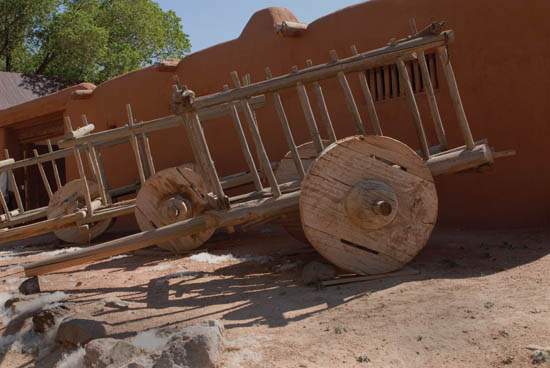
Traditional Farm Heritage
The Descendent
“We’re buying back some of the land that belonged to us.”
Eduardo Velarde grows peaches, apples, plums, apricots, and nectarines on his farm in the rural northern New Mexico village that bears his family’s name.
Recounting his family’s legend, Eduardo Velarde says:
When Don Juan de Oñate first came on his expedition, my tenth- generation-back grandfather was his personal secretary. For his valor, they deeded him 52,000 acres, and he got to pick what he wanted. Then back in 1870-some, they took it all back, because it was a gift from a foreign country, and the United States doesn’t recognize foreign gifts.
But something, I understand, called the Homestead Act—President Taft signed it, and he deeded this piece of land to my grandfather. It’s about six acres since they cut the highway. It used to be about ten acres, and then when they made the four-lane in the ’60s they cut a bunch out. We’re buying back some of the land that belonged to us, and a lot of our relatives still have a lot of the land.
The acequia on this particular orchard is the Chicos Ditch. The other ones are on Garcia and Medio and there’s another one down there, I can’t remember the name. They’re all gravity flow from the Rio Grande. Ninety percent of the ditch is still in the original place where they dug it out. From what I understand, my relatives got a lot of Native Americans to help dig it out around 1608 or 1610, somewhere around then.
The Traditionalist
“Making foods and sharing them with your neighbors . . . sharing water . . . sharing labor . . . all these are things of the past.”
Estevan Arellano works an ancestral farm in the Embudo Valley, which has been in his family since 1725. Arellano is also a lecturer, journalist, and Spanish-language author. He is the translator of the first English-language version of Gabriel Alonso de Herrera’s Obra de Agricultura, a 1513 farming instruction manual used by Spanish colonists in the New World, now published under the title Ancient Agriculture (Salt Lake City: Gibbs Smith, Publisher, 2006). His farm has orchards, vineyards, and mixed fields grown in the traditional way of the first Spanish settlers. He also raises churro sheep, the original sheep the Spanish brought to the New World, and corrientes, the original cattle. He has been searching for the descendants of the original pigs that came from Spain but has not been able to find any. He recalls the early twentieth century and the changes that have taken place in northern New Mexico farming during his lifetime.
We would trade our fruits and vegetables by cambalache, which means barter, for other crops or for hunters’ meat like elk or venison. It was something like today’s CSAs [community-supported agriculture], except that we mostly dealt with relatives. Once, I remember, we traded a truckload of apples for a truckload of piglets. Those pigs will eat whatever you can’t sell or whatever falls on the ground. Now, today, I keep churro sheep. They eat apples, too.
We also used to sell from the back of a pickup truck or go house-to-house in Taos, but when we’d do this, we would mostly get Anglos who wanted to buy apples in one-pound bags. We Hispanics had larger families, so we sold to each other by the bushel.
You have to understand your own microclimate. People move in from outside the acequia culture and don’t understand it. This makes for a clash of cultures with outsiders, because they think they know more about sustainable agriculture, permaculture, and all that. It offends the local people, who have been farming the land for as much as four hundred years. How much more sustainable can you be?
In those days the farmers lived by certain principles. One of them was convicte de comida, which meant making foods and sharing them with your neighbors—anything from butchering an animal to making biscochitos. This is fading away as people shop individually at stores instead. Then there was apartamiento de agua, the Arabic concept of sharing water, and cooperación, or sharing labor. All these are things of the past. Los Alamos brought a cash economy to northern New Mexico, and then everything changed. People are too busy working or going to Indian casinos.
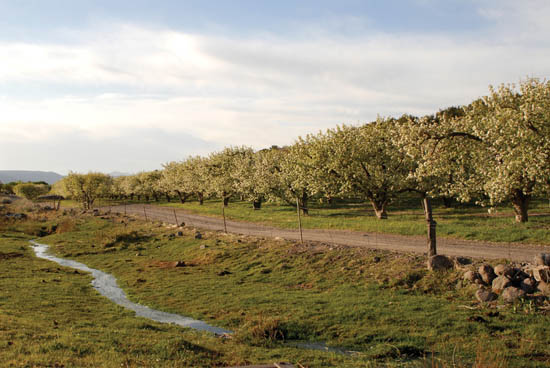
Farming has also changed in that many people have switched over to drip irrigation, often considered better in times of drought because it requires less water. But Arellano says this is an illusion. There would be enough water if the acequias were better maintained.
The banks of acequias were used as roads or trails between villages. Today we can’t do that because they’re overgrown with Russian olives, cottonwoods, and Chinese elms, so a lot of water is lost from the acequias. A single Chinese elm consumes two hundred gallons of water a day. And with all the vegetation, you can’t find the gopher holes that leak water out of the ditch. Priests used to parade along the acequias to bless them on San Antonio’s feast day, but now you can’t walk along the acequias any more, so the tradition has disappeared within my lifetime.
Drip irrigation, he claims, limits the range of crops that can be grown in a field because only the seeds planted in rows along the irrigation hoses get water. The traditional Spanish farmer’s field was more like a forest. A canopy of large trees protected smaller trees, which in turn protected grapevines, all sheltering lower crops from late and early frosts, down to the tiniest plants. One of his favorite things about traditional farming is the tiny, tasty volunteer plants like calite (lambs quarter) and verdulagas (purselane), which are used as herbs in traditional farm cooking. “We used to get huixtlacatle, a fungus that grows on blue corn, but hybrid corn doesn’t produce the fungus, so it has been lost. Other mushrooms also don’t grow because of the changes in the riparian environment as the acequias have gotten overgrown.”
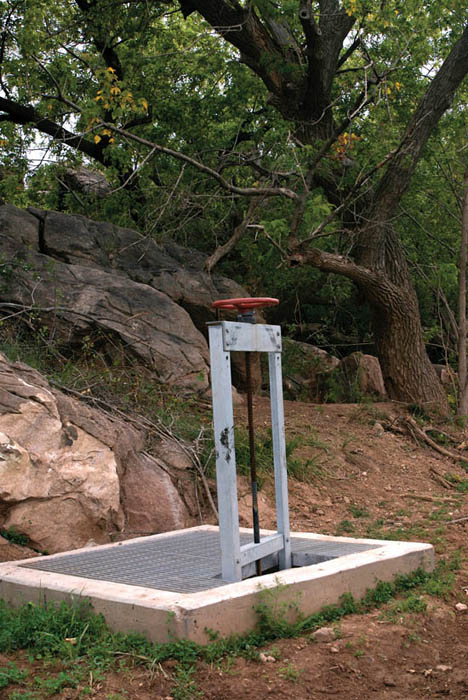
acequia gate
Acequia Culture Today
The Acequia Activist
“Traditionally we measure water in time.”
Miguel Santistevan, the Taos-area farmer and educator we met in the previous chapter, is among the leading figures in fighting to preserve New Mexico’s acequias through his activities with the New Mexico Acequia Association, founded in 1990 to provide a unified presence for the thousand or so individual acequias. Here he explains how acequia culture has shaped northern New Mexico and speaks of the challenges that confront acequias and the small farmers that depend on them today.
You hear complaints about people hoarding water or fighting over the water, but back in the day, water was the central thing that was shared. We had an age-old tradition, thousands of years of sharing water, all the way back to the Middle East. You always share what you have with others. I came across stories that during the Depression or during hard times, one family would make soup with a bone, and then they would take the bone to their neighbor so they could get a little bit of protein and get that flavor in their soup as well. Back in the day, when you were making chicos, it was a community event. Everybody would come and help out, and then the next weekend you would be at someone else’s house helping. You could always rely on your neighbors and your extended family to help.
Nowadays it’s everyone out for themselves. Even in agriculture, in the sustainability movement, sharing is the part that’s lacking. We’re not figuring out how to work with each other and how to rely on each other. To me, that’s a so-called luxury—it could also be called a sickness—of the modern economy. Everybody takes care of their own selves. How many people are living in two- to three-thousand-square-foot houses, and they’re just a couple without kids? And they’re not even living here year-round. They consider having an empty house a luxury. Then other people look at that and say, if I work hard I can have that.
But I say, if I work hard, I can be planting another half acre or another acre. To me, that’s wealth—having more seeds, more animals, more connection to my system, whether it be the water, the animals, the soil, the crop diversity, the insect life, the wildlife, the fruit trees. To me that’s the wealth of what I really have going on here, because as I see it, money comes and goes. I could buy some beer, I could go to the movies, and I’ll still have money to do that later, but if I don’t plant this corn, that can’t be replaced and there’s no money that can get that back.
If you look now, our acequias are irrigating a lot of hay and alfalfa. But the traditional Native American crops—the maíz, that’s definitely Native American, the calabaza (squash) is also Native American, the frijoles (beans) are also Native American. And other crops are also important—the frost-tolerant crops: the alverjon (peas), the lentejas (lentils), the garbanzos, the havas (fava beans)—so we get a jump on the season that the Native Americans didn’t necessarily have. We can be planting in February or March because those crops went through that breeding process in the Old World. So you put those together—the Native American depth of agriculture and land management with the Arabic, Middle Eastern, and Spaniard land management.
When the Spaniards came, they brought a whole crew of Claxcalteca Indians from what is Veracruz now. People envision the Spaniards coming over here and building the acequia system, but they didn’t do that. They hired the Mexicanos to put in the acequias. People like me, I would say that at least half of my blood is Mexican Indian, because that’s who came up here with the Spaniards. And then there’s also other native blood in my veins. I have a great-great-grandmother from Taos Pueblo, and there are stories of Apaches and Comanches stealing kids and all these things that happened. And the genízaro phenomenon—there was a time when renegade Comanches, Apaches, and Utes would come into a village and steal kids and sell them to Spanish landowners. Those people would be baptized and would lose their native identity and become hispanicized Indians or genízaros.
I have Vargas in my name; my grandmother’s maiden name is Vargas. So one of our cousins says, “Oh, we’re a direct descendant of Diego de Vargas [the Spanish governor who led the reconquest of New Mexico after the Pueblo Revolt of 1680].” And I say, “Well, that’s excellent, but it could be that we’re a direct descendant of Diego de Vargas’s house servant, for all we know.” A lot of people freak out when they hear that. They say, “Oh, my god, I’m from Spain, I’m a Spaniard, I’m pure Spaniard.” Then they get upset when I say there’s not even a pure Spaniard in Spain. I’m proud of being Mexicano, and I welcome all these immigrants, because they’re my cousins. We’re all—Somos gente de maíz [“We are people of the corn”]. The other day this Mexicano came out here, and I was honored to have him here, and he saw my cornfield and said, “Hey, this reminds me of home.” And I said, “You are home, man—Nuevo Mexico.”
Acequias are mostly a northern New Mexico thing, and southern Colorado. There are a whole bunch of them tucked away around here that the state engineer doesn’t know about, that nobody knows about except the people who are working them.
These water systems come from both the mountain and the river. A lot of people consider the acequia to be just the actual channel, but the way it was originally set up, the acequia is connected to the entire watershed, so any springs you have in the watershed, even on private property, belong to the acequia. Some people think that because a spring is on their property, it’s theirs, but it’s not. It’s communal property—all the water belongs to everybody. When people try to privatize a spring, it’s unacceptable. It’s a continuation of colonization, in my opinion.
Acequias are connected to the entire watershed, and the upper watershed is like a sponge. The snowmelt dissolves into the soil, into the aquifer. When you see the river, the river isn’t water flowing on top of the ground, it is water that is upwelling from the aquifer underneath the river. So we divert some of that water into the acequia, and most of that water returns to the aquifer, creating a hydrological cycle between the river and the acequia, extending the flood plain, extending the riparian area beyond what would otherwise exist.
Acequias are all about gravity flow. You don’t need any fossil fuels. Nowadays a lot of people are saying, well, I want to pipe my acequia. There’s no reason I should be cleaning out this ditch, because I can just put a pump in the river. But that’s dangerous, because the acequia . . . it’s not just the ditch and the water, it’s the whole system of water sharing.
For example, I have an acre of land, so I get the water for a certain amount of time. If everybody needs the water, then everybody gets that amount of time, typically four hours for an acre. If there’s a lot of water, I get a lot of water. If there’s a little bit of water, I get a little bit of water, and I’d better figure out a good way to use that water.
But now people say, “I could just put a pump in the river. The state engineer says I have 3.2 acre-feet of water, so I’m just going to pump that out.” That’s where the logic falls apart, because they’re measuring that water in volume, and traditionally we measure water in time. It’s a huge disconnect. That’s what’s creating this discrepancy between what is the reality of the water situation and what the engineers and lawyers think is going on in their air-conditioned offices in Santa Fe. Because it has to rely on water pressure. You know, there are some acequias that are level or even flow uphill, and they rely on the whole hydrological system to push that water along.
As we start running out of water, they might adjudicate these systems and say, “Okay, there are ten people on the acequia and five of you aren’t using it, so you lose that water right. You five that are using it, you can only divert this much water.”
They have all these equations, they call it the PDR—the Project Delivery Requirement—which equals the amount of water that each irrigated parcel requires according to their equation plus the amount of seepage that is lost to deliver it, and that’s the amount of water you’re allowed to divert. On paper that looks good, but if you cut down the amount of irrigation that can take place, you’re looking at a situation where there can be just a little bit of water in the acequia, like I saw in July—there was some water, but by the time I blocked it and diverted it, it only made it about a third of the way down the row because it all got consumed by the soil—so that’s not going to work for us. We need to divert the water so there’s enough pressure in the acequia so we can get the water on the land and do a good irrigation.
Some people say, “Well, you should go to drip irrigation,” but again that’s not respecting the original setup of the acequia. Drip irrigation is almost like putting your plants in a feed lot; you’re just irrigating this plant, it’s just getting little drops of water, but you stick a shovel in that soil and it’s just dry everywhere else. When you’re flooding an entire field, look at all these verdulagas, all these calites. I’m maintaining an agricultural ecosystem—there are things I didn’t plant that are coming up just because the water’s there, and I can use a lot of them for food, for medicine, for shampoo—I’ve got yerba de la negrita growing out there.
So there’s a more intense relationship I can have with this land by maintaining it as a flood ecology situation, plus recharging the aquifer so my neighbors down here who have wells are eventually going to get the benefits of me flooding my land here. It’s all part of that system. That’s not to say I’m against drip irrigation; I think in some cases it’s okay, but if it impacts the traditional functioning of the acequia, to where people say, “Well, I’m using less water than all you guys, so I should be able to pump out water whenever I want,” I say no, that’s not acceptable. You get water when it’s your turn, and you can put it in a tank and do drip irrigation later, but we cannot compromise the integrity of what it means for all of us to share this water and to have it equal within the acequia.
I don’t want us in a situation here where we’re hoarding the water. There’s plenty for everybody. I used to get all upset if people were stealing the water, because that’s such a shortsighted, limited viewpoint.
I’ve already gone through two hard years where there was just no water but at the precise moment it rains. You have to remember that another part of our culture here in northern New Mexico is our reverence toward God and our faith in God. We do not control the water. The water belongs to the earth, and the earth belongs to God.
In 2003 I had the most pathetic-looking cornfield you can imagine. More than half of it died. But the half that lived, I have that seed, and I planted some of that in this field when there was no irrigation. I planted twenty-four plants, and thirteen of them gave me corn, and I watered them once. So I never see it as a loss if I lose some of my crops; I can still go to the store, at this point, but I think those days are numbered to where the store is really going to serve our needs.
I have the luxury to adapt my crops. But in terms of the acequia systems here, most people agree that we need to share, that it belongs to everybody, and that’s traditionally how it was, and I’m hoping we go back to that. And we will. We’re going back to that because we’ll need to. If the water policy keeps going as it’s going, we’re going to run out of water. We’re only going to have water in the spring and whatever water we can get off the roof and whatever water we can recharge into the aquifer. It’s going to be a challenge—a crisis—but it’s also going to be an opportunity for us to work together.
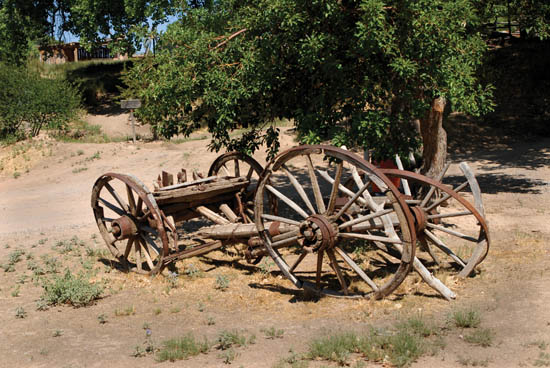
Dry Water Wars
The acequia system served Spanish and Indian farmers well for centuries, apportioning available water equitably among everyone who needed it. Unique to New Mexico, it continues today with about one thousand acequias still in active use. On behalf of small farmers, the acequia associations have assumed a role as one of several competing power blocs struggling with a strange, ever more complicated, tangle of water laws.
While New Mexico state law follows a variation of the “first in use, first in right” theory of water rights that prevails in most western states, the rights of Indian pueblos and rural acequia associations are in direct conflict with state law. The state measures water rights in terms of quantity, vesting owners with a right to use a given number of acre-feet of water each year. The acequia system, on the other hand, measures water rights in terms of time, giving users their share of the water flow in the ditch for a certain number of hours each week.
In 1913, the U.S. Supreme Court in the case of United States v. Sandoval overruled its previous 1878 Joseph decision and held that New Mexico’s Pueblo Indians were, in fact, Indians. That created a new problem, because the court had ruled just five years earlier that Indians were entitled to “prior and paramount rights to waters that border, originate in, or pass through a reservation.” During the thirty-eight years when Pueblo people were not considered Indians, about twelve thousand non-Indians had either bought plots of Indian land in good faith or simply squatted on them long enough to claim property rights. Restoring the Indians’ original water rights meant that the Pueblos and their non-Indian neighbors owned conflicting rights to the same water.
Piecemeal litigation over Indian versus non-Indian water rights kept New Mexico’s federal court occupied for decades, while growing population, increased urbanization, pollution, and interstate water compacts all placed increasing demands on the limited supply of water in the Rio Grande and its subsurface aquifer. Meanwhile, farmlands that had been in the hands of old Spanish farmers had been split up between heirs over many generations, always dividing plots into narrower and narrower strips so that each would keep its rights by fronting on a river or acequia. This translated into a multiplying number of wells and acequia gates, placing still more demands on the severely limited water supply.
The problem of water came to a head in 1966 with the filing of New Mexico v. Aamodt, which was a lawsuit brought forward to define the respective water rights of “non-Indian entities, Indians, federal agencies, state agencies, municipalities, and water associations” in the Pojoaque Valley. At the time, the demand for water in the valley exceeded the available supply by 50 percent in normal years and far more in times of drought. It was the ultimate dispute over “dry water“—legal rights to water that did not exist.
For many years, the Aamodt case lingered because a fluke of federal law allowed the judge to authorize payment by the federal government of legal fees incurred by most nongovernment parties to the lawsuit. Not surprisingly, hundreds of attorneys came forward to represent the hundreds of parties in the case, collecting millions of dollars in legal fees and hopelessly confusing the case with paperwork that filled entire rooms of the federal court clerk’s office. By the time the court ordered an end to the payment of interim legal fees in the early 1980s, the Aamodt case had become truly unsolvable. The court ordered the parties to agree on a settlement.
In 2004, the parties drafted a settlement agreement that begged the question of competing water rights by creating a regional water system that would satisfy everybody’s needs by piping additional water over the Continental Divide from the San Juan River to the Rio Grande. The sticking point was who would pay the costs of the water diversion. When it became clear that its share of the settlement cost would be more than $200 million, the federal government balked, and as of this writing, the case remains unresolved, making it the longest-lasting trial court litigation in United States history.
Added to the conflicting claims of Indian pueblos, private landowners and acequias, other factors have arisen to complicate the water situation. The rapidly growing cities of Santa Fe and Albuquerque have outstripped their ability to meet water demand by drilling wells into the Rio Grande’s underground aquifer, and as the aquifer level declines, the cities have sought to buy unused water rights from upstream owners such as the Jicarilla Apache Reservation and unappropriated water piped from the San Juan River. So far, little progress has been made in actually building a diversion project to carry the water from the Rio Grande to the city’s water systems.
To complicate matters further, for years New Mexico has been making up for water shortfalls by running a deficit on its obligations under an interstate water compact that requires the state to allow a certain amount of water to flow south to the big cotton fields and citrus groves in Texas. By law, New Mexico cannot divert water from any of its Rio Grande reservoirs when the water level in the largest of them, Elephant Butte Reservoir, falls too low to supply the water debt to Texas. Furthermore, the courts have ruled that water cannot be diverted from the Rio Grande system if it would cause part of the river to temporarily dry up, threatening a tiny native fish called the silvery minnow, which is on the federal endangered species list. For these reasons, the newly acquired water rights from the San Juan diversion, which Santa Fe and Albuquerque depend on for continued growth, may well prove as “dry” as other northern New Mexico water rights.
Ultimately, Indian pueblo sovereignty may make competing water rights meaningless because the state lacks power to enforce the law on tribal land. Faced with the endless Aamodt litigation, one of the smallest pueblos, Pojoaque, has responded by simply ignoring the water rights issue and building a lavish casino resort that includes three 18-hole golf courses, draining many times what their share would be under any proposed water settlement. This fait accompli makes a final agreement about water rights in the Pojoaque Valley all the less likely. At the same time, judges have showed no inclination to bring the Aamodt case to trial because, whatever decision the court might make, its precedent would profoundly affect water rights throughout the state.
The future of water in New Mexico is unforeseeable. Real estate developers have tended to proceed on the assumption that as cities and agribusiness require more water to avert disaster, the law will somehow find a way to provide this water at the expense of the Indians, the acequias, and the environment. But tribal and small agriculture interests, by digging in their heels, may yet prevail.
All that can be said for certain is that the water rights drama gripping New Mexico today is a microcosm of the twenty-first-century developing world, in which a growing, more urbanized population competing for increasingly scarce fresh water supplies will present a global crisis even more serious than the depletion of fossil fuels. New Mexico’s experience may or may not hold the answers; it certainly stands as a cautionary example—especially if it ultimately means that the acequias run dry.
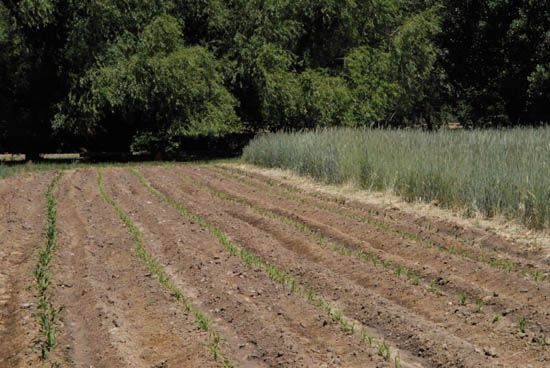
corn seedlings
The New Mexico Chile Story
While the early Spanish farmers’ most significant contribution to regional agriculture was undoubtedly hoofed livestock, which spread from the Rio Grande across the West over the next two hundred years, they also introduced a unique crop for which New Mexico has been famous ever since: chile.
Like most chile peppers, New Mexico chile evolved from a small, round, bright red berrylike fruit known as a chiltepín that grew on bushes in the foothills of Peru and was traded into Mexico in ancient times. It is the forerunner of the many different species of chiles found throughout Latin America and other tropical and subtropical parts of the world today, of which the most common is capsicum annuum, whose cultivars range from sweet bell peppers to jalapeños, poblanos, serranos, and New Mexico chiles. (A few common chiles, such as habaneros and cayenne peppers, are other species less closely related to New Mexico chiles.)
One remarkable aspect of capsicum annuum chiles is their ability to adapt to a wide variety of growing conditions. Early Spanish explorers brought chile seeds from Mexico and traded them to the Indians in the 1580s. A generation later, colonist farmers brought their own chile seeds. But while the same seeds in Mexico grew into a large perennial bush that bore chiles for up to ten years, in New Mexico with its winter freezes it became an annual that had to be replanted each year. The long, tough-skinned new strain looked and tasted different from other Mexican chiles. In fact, New Mexican chiles grown in different areas, such as Hatch in the south and Chimayó in the north, taste differently. In 1896, Emilio Ortega—a member of the Ortega family whose name graces a leading brand of canned Hatch chile—moved to Ventura, California, bringing a supply of New Mexico chile seeds with him. The chiles grew well in the southern California climate and became what are known today as Anaheim chiles. Although they look the same as New Mexico chiles, the taste is so different that they cannot be used in traditional green chile recipes.
New Mexico chile is sold in its green and red phases. (Besides naming chile as an official state vegetable—though botanists will tell you it’s technically a fruit—the New Mexico State Legislature has formalized an official state question: “Red or green?”)
In general, New Mexicans prefer to eat chile in its green state, before it has fully ripened, as a vegetable. The chile pods are roasted in rotating wire mesh cages over a gas flame until the indigestible outer skin hardens and starts to blacken. The skin will slide easily off the soft flesh inside, which is then split open, the veins and most of the seeds are removed, and the green flesh is cut into strips or diced. After roasting, it can be frozen at any stage in the process. Chile roasters from Hatch with semitruck trailers full of green chiles are a common sight on roadsides, street corners, and supermarket parking lots in all New Mexico cities during the late August and September harvest season.
By mid-September, the chile pods turn red and are no longer eaten as a vegetable. Instead, the pods are tied together in long ristras and hung out to dry in the sun. In the southern part of the state, they are also spread on rooftops to dry. The dried red chile is finely ground and cooked into a smooth sauce that tastes completely different from green chile. It can also be coarse-ground for use as a spice in stews and other recipes. Fine-ground red chile is also mixed with powdered cumin, oregano, and garlic to make chili powder. New Mexico produces virtually all the supply of this spice in the United States.
Most chile is grown in two distinct regions of New Mexico. The Hatch area, which has grown to include the outskirts of Las Cruces, La Mesilla, Deming, and smaller villages like Arrey and Derry, has long been reputed to produce the best chile, thanks to the proximity of the agricultural college at New Mexico State University.
In 1907, Fabián García, a professor of horticulture at the university, dedicated himself to developing new strains of New Mexico chile by interbreeding pods from different valleys nearby. Before then, chile’s piquancy was wildly unpredictable. One pod might be bland, while another plucked from the next bush might be mouth-blastingly hot, and there was no way to predict which was which until you tasted it. He developed a new strain called Fabián García’s, the first to deliver crops with even, predictable heat. Since then, NMSU has steadily improved chile crops, releasing new strains such as Nu Mex, NuMex, R Naky, Nu Mex Joe Parker, Rio Grande 21, and the popular Big Jim, or New Mexico 6.
At the same time, chile growing in southern New Mexico has grown increasingly industrialized. The small farmers of generations past have been bought out by large landowners, and the few mom-and-pop farms that still operate there are at the mercy of chile-processing plants such as Bueno, Biad, Cal-Compack, and Cervantes. Growers employ about fifteen thousand Mexican guest workers to harvest the chile for low piecework pay, amounting to about ten cents per pound for picking, carrying, and unloading the chile, without health care or workman’s compensation. Because of epidemics of chile crop diseases such as chile weevils and the curly-top virus, in recent years Hatch-area chile growers have used more and more pesticides, fungicides, and herbicides, which not only pose a health threat to fieldworkers but also contaminate the groundwater throughout New Mexico’s largest agribusiness farming area.
At the opposite extreme, around the northern village of Chimayó, east of Española, farmers have been growing the same strain of chile from the same seed source for four hundred years. Production is on a small scale—you will see vendors at farmers markets with a half-dozen one-pound baggies of roasted chile for sale. The hotness of Chimayó chile is as unpredictable as always, and the taste is quite different from chile grown in the south. For that reason, many people think Chimayó chile is best when it is allowed to turn red, dried, mixed to homogenize the hotness, and powdered for red chile sauce. Chimayó chile is the closest we can experience to the original chile that Spanish settlers and Indians grew in the 1600s.
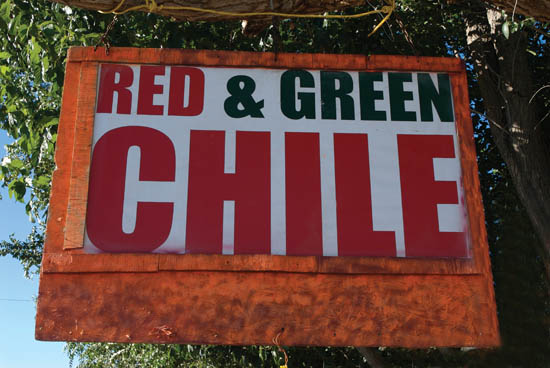
Cooking with Chile
Here is a selection of traditional chile recipes, along with a few not-so-traditional ones we’ve developed over the years or come across in our travels around New Mexico.
Red chile, powdered or crushed, is available in supermarkets or Mexican groceries in most parts of the United States. Green chile is ubiquitous in New Mexico but can be hard to come by in other parts of the country. Many a New Mexico–style restaurant in places like New York and Miami has failed because of the problem of getting good green chile.
Fresh roasted green chile does not travel very well. In the car, its tantalizing smell can be way too much of a good thing, and if it is not thoroughly wrapped and sealed, the juice can stain or cause caustic burns on fabric and other surfaces. It is not allowed in carry-on baggage on airplanes. Dried or canned, it loses much of its distinctive flavor.
Green chile does keep well frozen. In fact, many New Mexicans buy a bushel of roasted chile in the fall, put it up in sandwich-size freezer bags and thaw as needed, providing a year-round supply of good-as-fresh green chile. We have successfully sent containers of frozen green chile to students and wandering New Mexicans in other parts of the country on dry ice via FedEx, but the cost factor makes this a solution of last resort.
You can order frozen green chile shipped via FedEx or Airborne Express from Wholesale Hatch Chile (www.wholesalechile.com; 888-336-4228) or Bueno Foods (www.buenofoods.com; 800-952-4453). Again, the issue is cost. For example, Bueno sells packages of six 13-ounce containers of green chile by mail order for $25.99, which is only slightly more than a New Mexico supermarket would charge; the catch is that shipping and handling costs an extra $50.
The best solution we’ve found is to find a supermarket where you live that also has locations in New Mexico, such as Albertsons, Smith’s, or Whole Foods. These stores will often special-order frozen chile at prices that are not much higher than you’d pay in New Mexico. The minimum order quantity is likely to be around fifty to sixty pounds.
If you can’t find an affordable and practical source of New Mexico green chile, use oven-roasted, peeled, and chopped Anaheim chiles and add a few Serrano chiles (split these small green chiles, remove the inside core and seeds, and chop finely) for flavor—a poor substitute for the real thing, but tasty enough.
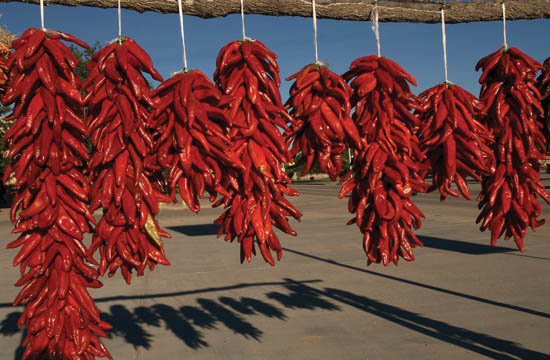
Traditional Green Chile Stew
This is the most traditional of all New Mexico dishes, the one that defines the state’s cuisine. Elsewhere in the Southwest, you may find something called green chile stew in restaurants, but it is not even remotely the same.
Serves 6
| 2 pounds cubed pork |
| 1 tablespoon olive oil |
| 1 large onion, chopped |
| 2 cloves garlic, minced |
| 2 cups water |
| 2 cups roasted, peeled, deveined, and chopped fresh or frozen green chile |
| 4 medium red potatoes, diced skin-on |
| 1 teaspoon salt |
| 1 teaspoon dried oregano |
| 1 tablespoon fresh chopped or dried cilantro |
In a large cooking pot or Dutch oven, brown the pork in olive oil. Add the onion and garlic and continue to sauté until the onion becomes transparent. Add the water, green chile, and potatoes. Bring to a boil, and then reduce heat. Add the salt, oregano, and cilantro. Simmer for 2 to 3 hours, adding more water as necessary. Serve with warm flour tortillas.
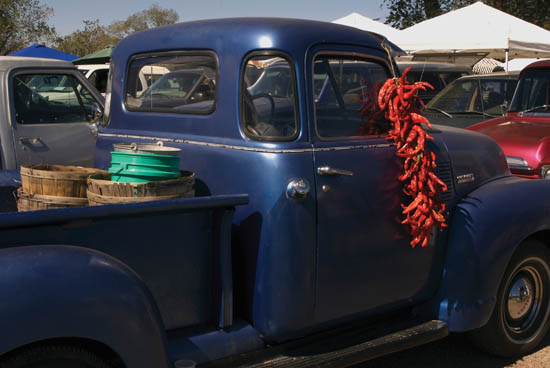
Richard’s Green Chile Bison Stew
Variations on the basic green chile stew concept are endless. We’ve seen it made with everything from piñon nuts to chorizo, and then topped with sour cream, raw onions, or avocado slices. Feel free to use your own ideas and experiment, as many New Mexicans do. It’s a hard dish to really screw up. Here is my personal green chile stew recipe, which I’ve been serving for twenty years.
Serves 8
| 1 pound ground bison |
| 1 tablespoon olive oil |
| 1 large onion, chopped |
| 4 cups vegetable broth or beef broth |
| 2 cups roasted, peeled, deveined, and chopped fresh or frozen green chile |
| 1-1/2 cups soaked and precooked posole, or 1 can white hominy |
| 1-1/2 cups soaked and precooked black beans, or 1 can black beans |
| 1 small can (4.25 ounces) sliced black olives, drained |
| 2 tablespoons chopped fresh cilantro |
| 1 teaspoon cumin |
| 1 teaspoon cinnamon |
| 2 teaspoons vanilla extract |
| 3 Roma tomatoes, quartered and sliced into chunks |
In a large cooking pot or Dutch oven, brown the ground bison in olive oil, and then add the onion and continue to sauté until the meat is crumbly and onion pieces are transparent. Add the other ingredients except the tomatoes. Bring to a boil, reduce heat, and simmer covered for 2 hours, adding water if necessary. Add the tomatoes during the last 20 minutes of cooking. Serve with warm flour tortillas.
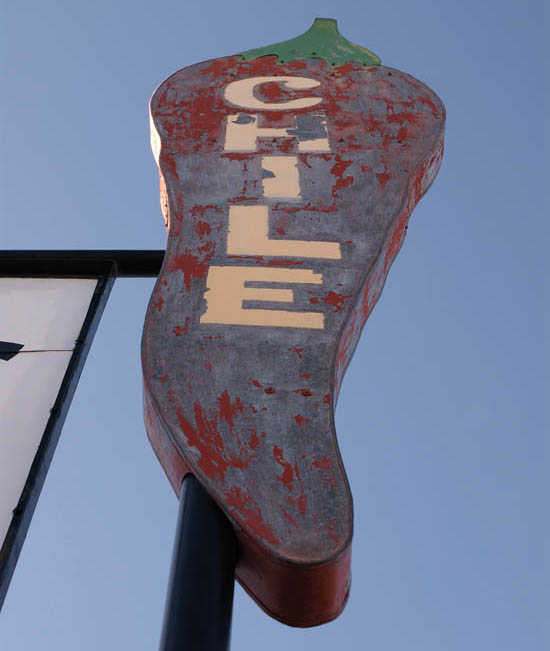
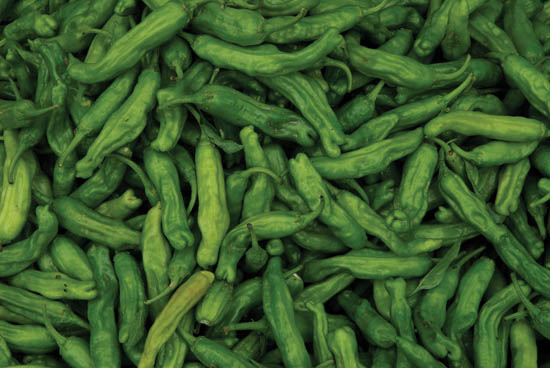
Traditional Posole Stew
This is the “other” traditional New Mexican stew dish besides green chile stew and Three Sisters Stew. It is especially popular during the Christmas season, when many village households keep a pot simmering on the stove to serve to drop-in guests.
Serves 6 to 8
| 2 pounds boneless pork loin, cubed |
| 1 tablespoon olive oil |
| 1 medium onion, chopped |
| 4 cloves garlic, minced |
| 4 dried red chile pods, crushed, or 2 tablespoons crushed red chile |
| 2 cups white or yellow posole, either bagged in liquid or nixtamalized and soaked overnight (see Three Sisters Posole on page 19)* |
| 5 cups chicken broth |
| 1 teaspoon dried oregano |
| 1 teaspoon salt |
| 2 medium tomatoes, quartered and sliced into chunks |
| Chopped cilantro |
In a large skillet, brown the pork in the olive oil over medium high heat, stirring constantly. Lower the heat to medium, add the onion and garlic, and continue to sauté until the onion is transparent.
Place the cooked meat, onion, and garlic in a large cooking pot or Dutch oven. Add all remaining ingredients except the tomatoes and cilantro. Cover and simmer for 4 to 6 hours, adding liquid if necessary. Add the tomatoes during the last half hour of cooking. Garnish with cilantro and serve with flour tortillas.
*For a quick version, substitute a large 16-ounce can of white or yellow hominy for the posole.
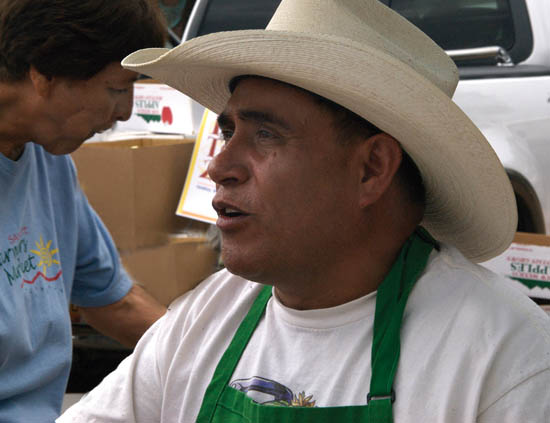
Crescencio Ochoa
Traditional Enchilada Casserole
Blue corn enchiladas filled with cheddar cheese, ground beef, shredded chicken, or turkey, are the most popular dish served at New Mexican restaurants in Santa Fe, Taos, and Albuquerque. We were surprised to learn that this familiar dish bears little resemblance to the enchiladas traditionally made in northern New Mexico. In our interview with Estevan Arellano, he described how different the enchiladas his mother used to make on the farm were from the kind served in New Mexico restaurants today. Based on his description, we surveyed a number of longtime traditional farmers in the Velarde and Embudo areas and developed this recipe for the kind of enchiladas old-timers used to make.
Serves 4
| 10 dried red chiles |
| 3 cups water |
| 2 cloves garlic, minced |
| 1 cup chopped onion |
| Olive oil |
| 12 blue corn tortillas, preferably homemade (see page 15) |
| 1 pound cooked, deboned, and shredded chicken |
| 1 cup stewed and crushed tomatoes |
| 4 eggs |
To make red chile sauce:
Rinse the chiles and place them in a cooking pot with the water. Bring to a full boil, reduce heat, and simmer for 20 minutes until soft. Meanwhile, sauté the garlic and onion in olive oil. Add to the chiles. Do not drain. Put the chiles, water, onion, and garlic in a blender and purée until smooth. Salt to taste.
To make enchiladas:
Preheat oven to 375 degrees F.
In a shallow casserole dish, place one layer of four tortillas to cover the bottom. Spread one-half of the chicken meat and one-half of the crushed tomatoes over the tortillas, and then add another layer of tortillas and the remainder of the chicken and tomatoes. Add the final top layer of tortillas. Pour on enough red chile sauce to cover the top. Bake covered for about 20 minutes. Then pour each of the raw eggs on top, evenly spaced so one yolk tops each tortilla. Bake uncovered for 10 more minutes or until eggs are cooked to taste and sauce is bubbly.
Note: The same recipe can be made with chopped green chile instead of red chile sauce. Red chile enchiladas are traditional, but green chile enchiladas are more popular these days. Surprisingly, enchiladas were traditionally made without cheese. If you prefer to top them with cheese, use queso ranchero (available in Mexican grocery stores) or Monterey Jack. Yellow cheeses such as cheddar and Colby were not traditionally used in New Mexico cooking.
Enchiladas Durango Style
Over the centuries, many other styles of enchiladas have been brought up the Camino Real to New Mexico from various parts of Mexico. This unusual version originates in the state of Durango and likely came here during late colonial times, when the churches in Santa Fe were under the jurisdiction of the Archdiocese of Durango and many people migrated from that area.
Serves 6
| 1/2 cup dried and crushed red chile |
| 1 cup hot water |
| 1 clove garlic |
| Pinch of cumin |
| Pinch of salt |
| 1 bar (about 1.4 ounces) dark chocolate |
| 1 cup grated ranch cheese or Monterey Jack cheese * |
| 3/4 onion, chopped |
| 2 tablespoons butter |
| 12 corn tortillas |
To make the enchilada sauce, soak the crushed chile in hot water for five minutes. Place it (including the water) in a blender along with the garlic, cumin, salt, and chocolate. Purée, pour into a saucepan, and place on the stove over low heat until thickened. Mix the cheese and the onion together.
Pour a portion of the enchilada sauce onto a plate. Melt a portion of the butter in a skillet, and then heat a tortilla for 15 seconds on each side, until soft. Immediately drag the tortilla through the enchilada sauce to coat one side. Place the tortilla on a plate, chile side up, fill it with the cheese and onion (or other stuffing) mixture, roll it, and set it aside on another plate.
When all 12 enchiladas are rolled, smother them with the remainder of the enchilada sauce and top with grated cheese. Serve with beans, rice, and lettuce on the side.
*These enchiladas can also be stuffed with shredded chicken or ground beef.
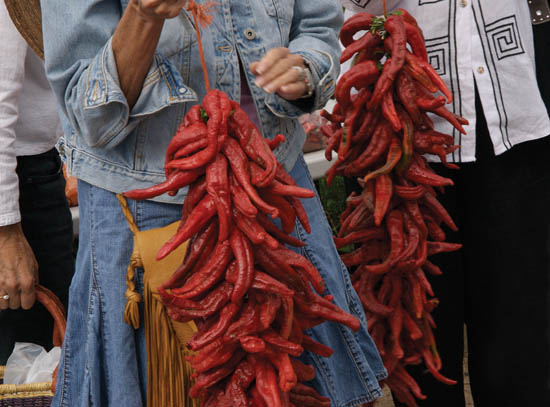
Chiles Rellenos
Relleno means “refilled” or stuffed. This is the traditional New Mexican version of chiles rellenos, a popular dish that takes many different forms throughout Mexico.
Serves 4
| 8 whole green chiles, roasted and peeled |
| 1 cup grated Monterey Jack cheese |
| 3 raw eggs, yolks separated from the whites |
| Pinch of salt |
| Pinch of pepper |
| Olive oil |
| 2/3 cup all-purpose flour |
| 1 cup stewed and crushed tomatoes |
Preheat oven to 350 degrees. Carefully slice each chile pod down one side. Remove the seeds, leaving the stem intact. Fill each chile with grated cheese, and then fold the sides of the chile together. Beat the egg yolks until smooth, adding the salt and pepper. Beat the egg whites until stiff and fold into the yolks.
Pour a shallow layer of olive oil in a skillet. While the oil is heating, spread the flour on a clean surface. Carefully drag each chile through the flour, and then sprinkle a little more flour on top. Holding the chile by the stem and the tip, dip it lightly into the egg batter. Immediately place it in the hot oiled skillet. Brown on both sides, and then place it on a paper towel to drain.
Put the breaded chiles into a baking dish or cake pan. Pour the stewed tomatoes over the top. Bake uncovered for 30 minutes.
